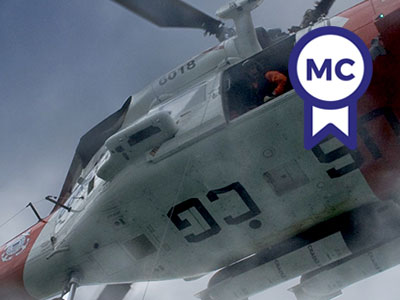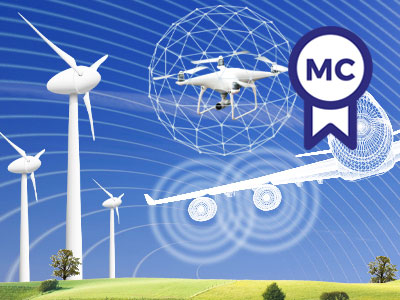Overview
An overview of aerodynamics of rotors, with emphasis on Horizontal Axis Wind Turbine rotors.
Rotor and wake aerodynamics are key to many applications such as helicopter and propeller rotors in transport and wind turbines for electricity generation. But rotors have a tendency to generate three-dimensional unsteady aerodynamic phenomena that are complex both to understand and to model.
For anyone working in the development and production of helicopter or wind turbine blades, this course is invaluable. It will deliver a depth of knowledge of the science and an ability to apply the technology that will enhance the careers of those already in the industry and the prospects of those wishing to enter it.
The course focuses on the following topics:
- Momentum theory applied to rotor simulation and design and potential flow models for rotors
- Airfoil aerodynamics
- Unsteady aerodynamics
- Aeroacoustics
- Wake aerodynamic
After successfully completing the course, you will be able to:
- design or source models which can represent the aerodynamics of different rotor configurations
- appraise different models and critique their suitability
- analyze complex rotor flows (rotors in yaw, wind farms, etc.)
- identify and summarize the main fluid phenomena and evaluate their interaction
- integrate different models to analyze the flow and combine the different models, evaluating their limitations and overlap
- design a rotor from an aerodynamic perspective
Modelling can be carried out in any programming language, for example MATLAB, C, or Python.
Earn a Microcredential with this course
A Microcredential is an additional quality certification for small educational units. It shows what knowledge, competence and experience the participant has gained upon successful completion of the course. A Microcredential is awarded in the form of a digital badge which can be shared and is instantly verifiable.
This certification is awarded to participants who enroll and complete the course starting on February 12, 2024 or later.
More information
Details
To effectively conceptualize and design a rotor, it is necessary to combine the fundamental and modeling perspectives of the rotor. In this course, we provide an overview of the phenomena in the aerodynamics of rotors, with special emphasis on Horizontal Axis Wind Turbine rotors. Propellers, vertical axis (crossflow) wind turbine rotors and helicopter rotors will also be addressed, but in less detail.
There will be hands on introductions to the different computational models used nowadays to analyze the aerodynamics of rotors, with a focus on vortex models.
The course includes:
- An introduction to rotary wing aerodynamics with applications in aircraft, propulsion, fans and wind turbines.
- A discussion of conservation laws, actuator disk/momentum theory and limitations.
- An examination of helicopter rotor vertical flight and "windmill brake" state. How to calculate figure of merit.
- Understanding the Betz optimum for wind turbines and lift and drag devices and the blade element momentum method.
- "Tip" correction methods, correction for finite number of blades and heavily loaded rotors are examined.
- The aerodynamic characteristics of airfoils for rotor applications and the properties of pitch and stall controlled wind turbines are explored as a precursor to a wind turbine rotor blade design exercise.
- There is a study of vortex line methods, vortex wake structure, Frozen and free wakes and vortex core modeling. These are followed by the exploration of vortex panel methods, advanced wake models and the acceleration potential method.
- Detailed study of rotor near wake structure, experimental wake velocities and wake vorticity structures.
- Examination of 3D effects, stall delay, yawed flow and dynamic inflow and autogiro and helicopter rotor aerodynamics in forward flight.
- Unsteady aerodynamics and dynamic stall effects, the effects of tower shadow and wind shear and Theodorsen's Theory.
- Vertical axis wind turbine rotors and the Voight-Schneider propeller
- Effects of inflow turbulence intensity on blade loads and near and far wake structure
- A study of wind farm aerodynamics looking at rotor-wake interaction, single and multiple wakes and the effects on loads and performance.
Video Lectures and Online Office Hours
The lectures of this course are broadcasted live online. Live attendance is possible but not required - the videos will be available around an hour after the lecture which can be watched later. In addition, there will be online office hours with the instructor on a weekly basis, which are also optional.
Assignment
Students will develop and program different aerodynamic models currently used in industry, and apply them to analyse relevant rotor operations.
Literature and Study Material
Course lectures - students can download the course lectures, background material and assignments from the accompanying e-learning platform. This e-learning platform will also be used extensively for submitting exercises and response to students.
Recommended literature - the recommended literature for each chapter will be indicated in the course lectures.
Assessment
Continuous assessment through individual online assignments, three group assignments and a final exam via online Proctoring.
Date of proctored exam and resit will be communicated during the course.
Qualifications
Certification
If you successfully complete your online course you will be awarded with a TU Delft certificate.
This certificate will state that you were registered as a non-degree-seeking student at TU Delft and successfully completed the course. The certificate will also indicate the number of ECTS credits this course is equal to (4 ECTS) when this course is taken as part of a degree program at the university.
This course is a MSc course in the Faculty of Aerospace Engineering. If you decide that you would like to apply to the full Master's program in Aerospace Engineering, you will need to go through the admission process as a regular MSc student. If you are admitted, you can then request an exemption for this course that you completed as a non-degree-seeking student. The Board of Examiners will evaluate your request and will decide whether or not you are exempted.
Chartered Engineering Competences
All our online courses and programs have been matched to the competences determined by KIVI’s Competence Structure, a common frame of reference for everyone, across all disciplines, levels and roles.
These competences apply to this course:
- A1: Extend your theoretical knowledge of new and advancing technologies.
Admission
Below, you can find the expected prior knowledge required to participate in this course. Please note that these are provided as indications only. TU Delft will not request proof of this prior knowledge through copies of degrees or diplomas. However, it is your responsibility to ensure that you possess the necessary knowledge, acquired through prior education or relevant work experience.
- A relevant BEng or BSc degree in a subject closely related to the content of the course or specialized program in question, such as aerospace engineering, aeronautical engineering, mechanical engineering, civil engineering or (applied) physics.
- The learning objectives of the following TU Delft courses:
- Applied Aerodynamics or else Fluid Dynamics
- If you do not have experience with MATLAB but with other programming language, you can still follow the course, however it is recommended to allocate additional time for mastering it.
- Level of English equivalent to one of the following certificates:
- TOEFL score 90+ (this is an internet-based test)
- IELTS (academic version) overall Band score of at least 6.5
- University of Cambridge: "Certificate of Proficiency in English" or "Certificate in Advanced English"
Admission process
In order to complete your admission process you will be asked to upload a valid copy of your passport or ID card.
Contact
If you have any questions about this course or the TU Delft online learning environment, please visit our Help & Support page.


